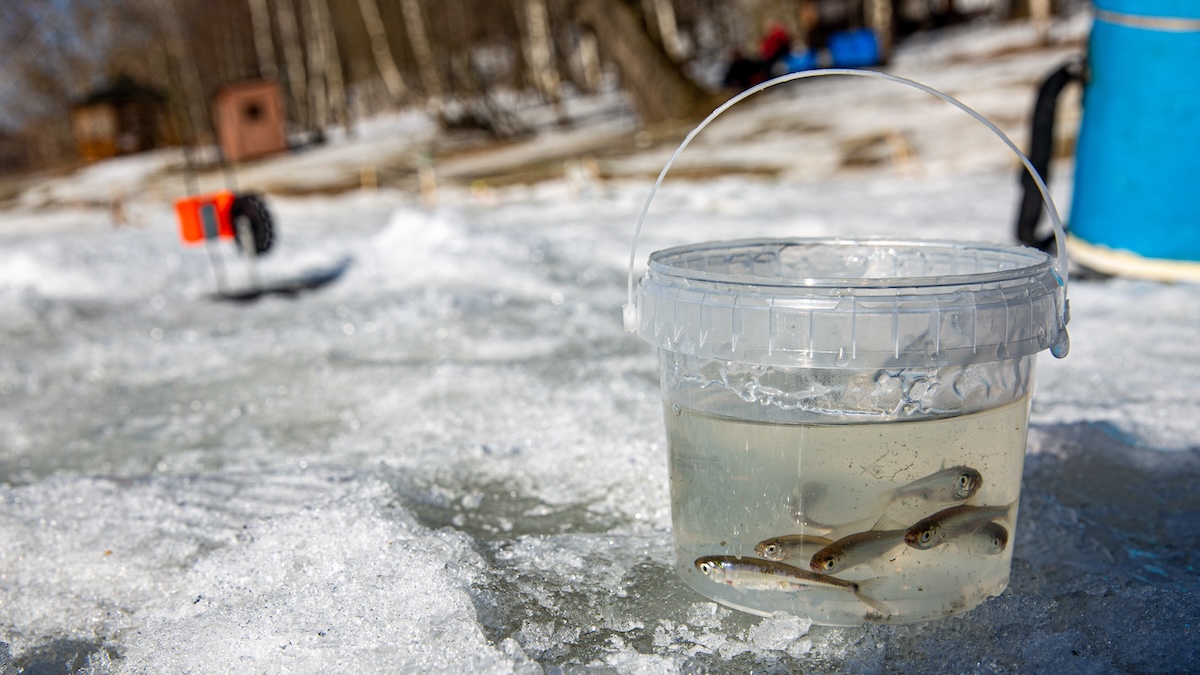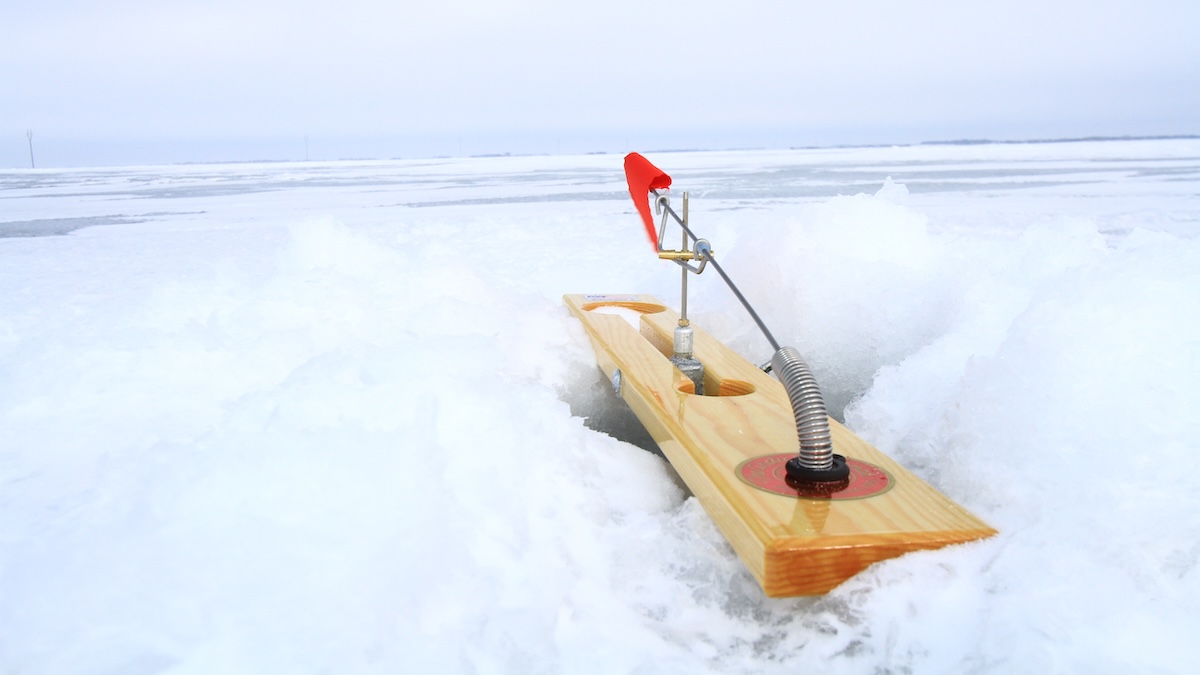Catching a big lake trout is one of the greatest challenges in the angling world. For most of the year, these fish live in sparse, constantly roving schools in the deepest, darkest parts of lakes and reservoirs. They’re hard to find, hard to catch, and many anglers go hours and even entire days without a strike.
However, as the old saying goes, there’s a time and a season for everything. Gardeners plant their annuals on the waxing quarter moon, pig farmers slaughter at the first frost, and bargain-hunting Christmas shoppers batter down the doors of shopping malls on the Friday after Thanksgiving.
No matter the activity, at some point during the year there will be a perfect storm of conditions that yields the best results. This magic window is especially pertinent in the outdoor world. If you want a big buck, you hunt during the rut. If you want to catch a bunch of trout, you fish during the biggest hatch, and if you want to catch a big lake trout, you fish through the ice.
How to Find Big Lake Trout Under the Ice
Lake trout or “mackinaw” are extremely temperature-sensitive fish. Though they can tolerate warmer water, they survive and thrive in water temperatures ranging from 46 to 59°F. Through most of the year, they prefer deeper water that allows them to hide beneath the thermoclines close to the bottom. These thermoclines act as barriers, stopping the big trout from moving into shallower, warmer water. However, when winter arrives and the cold water beneath the ice is an ideal temperature, the lakers are unleashed. Just like when the electric fences go down in Jurassic Park and allow the T-Rex to break out and devour unsuspecting tourists, the cold water of winter permits giant lakers to run rampant, hunting wherever and whatever they please.
Lakers will constantly be roving during the winter, moving on and off structure points in search of baitfish. Traveling in small packs, these big salmonids will dash into the shallows in search of schools of whitefish, smelt, shiners, panfish, and even other trout. Like a parent that finds their kid’s stash of Halloween candy, the lakers will feed gluttonously before moving back out into deeper water. The key to catching big lakers through the ice is to set up in the lake trout’s choice ambush spots.
Using your electronics or a bathymetric map, find points of structure in the lake or reservoir you’re fishing where baitfish and smaller gamefish will concentrate. The best spots will usually be in 10 to 80 feet of water and can include underwater humps and boulder reefs, saddles of shallow water between islands, shallow bays, sunken points, and even coves close to shore, so long as they’re immediately adjacent to deeper water.
Once you’ve found a few likely spots, drill some prospect holes and look them over with an underwater camera, fish finder, or transducer. But don’t just look for lake trout—look for large concentrations of baitfish and smaller gamefish that they may be feeding on, too. Drill your holes in a zig-zag or grid pattern so you can check and set up around a variety of different structures and depths, maximizing your chances of intercepting a fish.
Remember, big lakers can be caught in some surprisingly shallow places during the winter as long as there’s deeper water nearby, so don’t be afraid of experimenting a bit. Not long ago on an ice fishing trip out West, MeatEater’s Senior Fishing Editor Joe Cermele experienced this firsthand.
“Years ago, I had a chance to fish for lakers with the legendary Bernie Keefe on Lake Granby in Colorado. Bernie liked to swing for the fences, preferring to catch a couple giants over a pile of smaller fish,” Joe said. “He handed me a rod rigged with a 9-inch Hogy soft plastic. The only other time I’d ever thrown that particular lure was for bluefin tuna back East. I was skeptical, but Bernie was the boss. When I looked down the hole I got even more skeptical because I could see the bottom. It was only about 3 feet deep. I thought he was playing a joke on me, but I didn’t jig the bait 20 times and it got hit so hard the rod almost got yanked down the hole.”
There’s a method to Bernie’s madness.
“What Bernie hadn’t told me was that less than 30 feet away, the bottom sloped away to 20 feet,” Joe said. “He knew the only reason a laker would come this shallow was to grab a small brown or rainbow and bolt right back to the depths. It was a calculated move with a little risk, but his years of experience and intuition paid off. We landed three fish in that shallow water, all of which measured more than 40 inches. He had never tried a 9-inch Hogy before and totally used me as a Guinea pig, but I was OK with it.”
This leads me to my next key point about landing big lakers through the ice: using the right baits.

The Best Ice Fishing Baits and Lures for Lake Trout
While it’s true that a winter-crazed lake trout will eat just about any size bait that drops in front of them, as Bernie Keefe so aptly demonstrated to Joe, targeting big lake trout means using big baits. I’ve caught and cleaned 30-inch lakers that had 14-inch walleye in their stomachs, so if you’re using live baits, you’ll want to use the biggest ones available. Large, 6 to 10-inch gold shiners, dace, smelt, 12-inch suckers, and even (where legal) a live perch or sunfish you jigged up earlier are all my go-tos when setting up for a big laker. Rig the baits with a 1/0 to 3/0 octopus hook just beneath the dorsal fin so that they remain lively underwater while waiting to be T-boned by a cruising laker.
The lures you use while ice fishing for lake trout should also be large and provide a lot of flash and action when jigged. My favorites include large, 5- to 8-inch spoons like the Magnum Flutter Spoon and the Eppinger Daredevil with a large split shot clipped to the line 3 to 4 inches above the lure to help it sink and to provide extra action. Besides spoons, I use a lot of heavy 1- to 2-ounce jig heads with 2/0 to 6/0 hooks. Tip the jigs with 6- to 8-inch soft plastic like a XPS Single Tail Grub, a Magnum Superfluke, or—if you’re following Joe’s example—a 9-inch Hogy. Other lures like tube jigs and large jgging raps tipped with live or dead shiners can also be effective, especially when lakers are being finicky about taking other baits.
Of course, having a good spot picked out and using the right baits for lake trout won’t matter at all if you’re not using the right equipment to handle catching them.

The Best Equipment for Ice Fishing for Lake Trout
Lake trout are large and extremely powerful fish that are more than capable of breaking your average jigging rod. They also hit hard during the winter, so there’s no need to detect subtle strikes. In short, don’t bother fishing for them with the same light rod you use for bluegill or even the beefier rods you use for walleye. Instead, you’ll want to use a heavy-action jigging rod with a lot of backbone that gives you some torque to both effectively jig big lures and to fight against a hard-running laker. Pair the rod with a reel equipped with a good drag system that won’t lock up in cold conditions and spool it with 10 to 12-pound braided line, which is less likely to break when rubbed around the edges of an ice hole by a struggling laker.
Using tip-ups for lake trout is extremely effective when fishing with live bait, but you’ll want to use high-quality rigs that hold together well when battling heavy fish. The best will have an adjustable drag setting on the spool that can be tightened when using large live baits. This prevents your bait from setting off the tip-up and you from running around the ice like a chicken with its head cut off chasing false alarms.
Most tip-ups are strung with thick 30- to 50-pound braided nylon line, which is more than capable of hauling in a big mack. However, lakers can become extremely leader shy in heavily fished areas, so you’ll want to add a length of monofilament or fluorocarbon line to the end of the nylon line before tying on your hook. Take a large barrel swivel and tie one end of the tip of-up line to one end of the swivel and then add 2 to 6 feet of 15- to 30-pound mono or fluorocarbon to the other end of the swivel. This will help ensure that any leader-shy laker cruising by will absolutely smash your bait without any hesitation.
To get your baits down to the desired depth and keep them in the strike zone, you’ll want to add a bit of weight to your tip-up rig. Once your tip-up is baited, add a medium-sized split shot or two to the fluorocarbon or monofilament leader about 8 inches above the bait. This will help hold the bait down at your desired depth but still allow it to swim and struggle against the hook, making it the perfect target for an opportunistic laker.
The Time and the Season
Catching a big fish is probably the biggest motivation behind every fishing trip. Despite saying that we just like being out there when we’re fishing in beautiful conditions, deep in the back of our minds is the flickering hope that today may be the day we land a monster. That’s the best thing about ice fishing for lakers.
During winter, a season that most anglers view as a cold ball of suck that simply must be suffered through, the knowledge that it’s our best chance to catch a giant lake trout makes suffering through horrendous conditions worth it. It’s a beautiful parallel. For there is a time and a season for everything, and if you want a big lake trout, that time is right now.
Read the full article here

